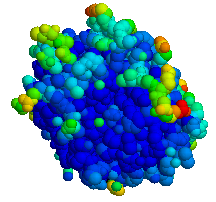Elastase


In
Forms and classification
Eight human genes exist for elastase:
| Family | Gene symbol | Protein name | EC number | ||
|---|---|---|---|---|---|
| Approved | Previous | Approved | Previous | ||
| chymotrypsin- like |
CELA1 | ELA1 | chymotrypsin-like elastase family, member 1 | elastase 1, pancreatic | EC 3.4.21.36 |
| CELA2A | ELA2A | chymotrypsin-like elastase family, member 2A | elastase 2A, pancreatic | EC 3.4.21.71 | |
| CELA2B | ELA2B | chymotrypsin-like elastase family, member 2B | elastase 2B, pancreatic | EC 3.4.21.71 | |
| CELA3A | ELA3A | chymotrypsin-like elastase family, member 3A | elastase 3A, pancreatic | EC 3.4.21.70 | |
| CELA3B | ELA3B | chymotrypsin-like elastase family, member 3B | elastase 3B, pancreatic | EC 3.4.21.70 | |
| chymotrypsin | CTRC | ELA4 | chymotrypsin C (caldecrin) | elastase 4 | EC 3.4.21.2 |
| neutrophil | ELANE | ELA2 | neutrophil elastase | elastase 2 | EC 3.4.21.37 |
| macrophage | MMP12 | HME | macrophage metalloelastase | macrophage elastase | EC 3.4.24.65 |
The four "pancreatic elastases",
Chymotrypsin is weaker at digesting elastin than the architypical pancreatic elastase.[4]
Some
Function
The fact that elastase can break down elastin in test tubes (while other proteases cannot) does not imply that there is a unifying function for all elastases in the living body. Instead, they each have their own role:
- The pancreatic elastase (as well as chymotrypsin) is responsible for digesting proteins in food. Note that "pancreatic elastase 1" is, in fact, not found in the pancreas, but produced in the skin.[5]
- "Pancreatic elastase 1" (CELA1) is expressed in skin keratinocytes.[6]
- Neutrophil elastase breaks down the Outer membrane protein A (OmpA) of
- In bacteria, secreted elastase breaks down host connective tissue proteins, causing tissue damage and inflammation. As a result, it's considered a virulence factor.[9]
Elastases of the serine protease type preferentially break down peptide bonds on the carboxyl side of small, hydrophobic amino acids such as glycine, alanine, and valine.
Role of human elastase in disease
A1AT
Elastase is inhibited by the acute-phase protein α1-antitrypsin (A1AT), which binds almost irreversibly to the active site of elastase and trypsin. A1AT is normally secreted by the liver cells into the serum. Alpha-1 antitrypsin deficiency (A1AD) leads to uninhibited destruction of elastic fibre by elastase; the main result is emphysema.
Cyclic neutropenia
The
Other diseases
Neutrophil elastase is responsible for the blistering in bullous pemphigoid, a skin condition, in the presence of antibodies. It may also play a role in the formation of abdominal aortic aneurysms (AAAs) and chronic obstructive pulmonary disease (COPD).
Role of bacterial elastase in disease
Elastase has been shown to disrupt
